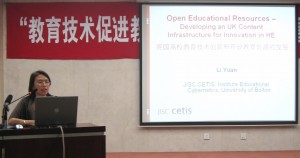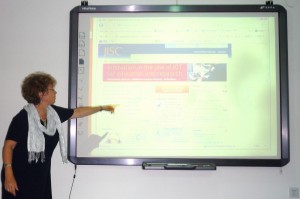Last week, I ran a workshop for the Lace project on “Learning Analytics: seeking answers at a time of big questions?” at the ALT-C14. The workshop was designed to bring together educators, researchers and developers to explore the promises and the pitfalls of using learning analytics in education. A brief introduction to the workshop is available here.
At the workshop, participants were invited to work in groups to develop scenarios around learning analytics in institutions and the issues and concerns related to using data in education, teaching and learning. About 30 participants from HE institutions, commercial companies and other educational organisations shared their thoughts, experiences and current projects and work on learning analytics.
Although four groups worked independently, not surprisingly, a common theme emerged at the plenary session: using learning analytics as a means to engage students. Several scenarios were developed around building dashboards to track student engagement; monitoring student performance and supporting individual and group online learning; and engaging international students, distance learners and students in MOOCs, etc.
Some questions around using analytics in institutions were discussed in the groups, such as:
- What are the motivations for using learning analytics?
- What systems, tools and data are available?
- How reliable are the data?
- How up to date are the data?
- How can data from multiple sources (VLE, Facebook, twitter) be monitored and analysed?
- How may we identify similar behaviours among high or low performance students?
General concerns were around privacy and data protection as well as accuracy of data collected about students and their online activities. Other concerns and suggestions included:
- Don’t get bogged down with the numbers
- Need better performance metrics and actual impact indicators;
- Need to have the right data and the right human interpretation;
- Danger of too much details that may discourage meaningful learning
- Course should be designed with learning analytics in mind
- Consider data formats and interoperability for data sharing
Due to the time constraints of the workshop, with participants from different types of organisations with various level of knowledge and skill on learning analytics, it was difficult to have a deep discussion around such broad and challenging topic. However, most participants thought that the workshop provided an opportunity for them to find out what other people and institutions are thinking and doing, and to share their ideas and experiences, in this case, how to engage students through learning analytics. If you would like to find out more about the Lace project and learning analytics, you can join the Lace community or participating in our future workshops.
 The LACE project workshop at the ALT-C14, 1st September 2014, Warwick, UK
The LACE project workshop at the ALT-C14, 1st September 2014, Warwick, UK
 Two weeks ago, I joined my colleagues, Oleg Liber, Director of JISC CETIS and Sarah Holyfield, Communications Director of JISC CETIS to present at
Two weeks ago, I joined my colleagues, Oleg Liber, Director of JISC CETIS and Sarah Holyfield, Communications Director of JISC CETIS to present at 
 was organised by the Higher Education Press in Beijing on 24th August. The speakers from different Chinese universities reported findings from their projects and research on use of technology to enhance teaching and learning. I was invited to give a presentation on
was organised by the Higher Education Press in Beijing on 24th August. The speakers from different Chinese universities reported findings from their projects and research on use of technology to enhance teaching and learning. I was invited to give a presentation on 

 Finally and most interestingly, we found a street storyteller using an old fashion technology –“Magic Lantern” to present Chinese history stories which attracted many people (different age, gender and culture) who came to visit the modern Shanghai.
Finally and most interestingly, we found a street storyteller using an old fashion technology –“Magic Lantern” to present Chinese history stories which attracted many people (different age, gender and culture) who came to visit the modern Shanghai.